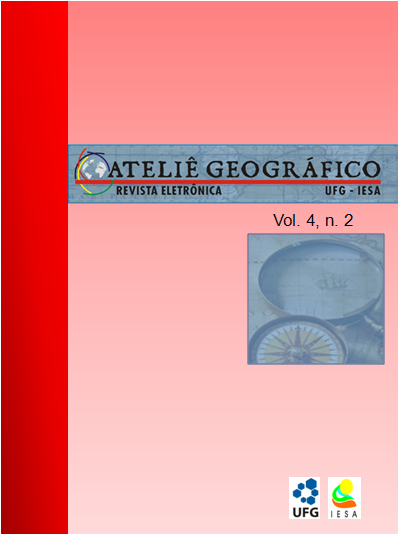O visível e o invisível: A paisagem arqueológica da morte em São Cristóvão e Laranjeiras – SE - DOI 10.5216/ag.v4i2.9915
DOI:
https://doi.org/10.5216/ag.v4i2.9915Resumen
O presente estudo tem por objetivo a caracterização da paisagem arqueológica da morte nas cidades setecentistas de São Cristóvão e Laranjeiras em Sergipe, utilizando as rugosidades e o que elas representam para a identificação dos antigos e atuais territórios da morte. Para realizar esse estudo utilizou-se a representação e a história como método de caracterização, uma análise totalmente qualitativa. Dessa forma, a premissa inicial é de que a morte formava uma paisagem dominante nas cidades a partir da sua relação direta com a religião católica. Nos dias atuais, as cidades que guardam vestígios dessa paisagem, como São Cristóvão e Laranjeiras em Sergipe, comportam uma leitura arqueológica. Analisando as rugosidades formadoras das paisagens da morte, percebe-se como no passado a representação da morte estava presente no cotidiano das pessoas. Nesse sentido, avaliou-se que existe uma paisagem da morte nestas cidades setecentistas, formada por rugosidades visíveis e outras invisíveis. As visíveis são constituídas pelas Igrejas, lápides e cemitérios ainda existentes. As invisíveis englobam tudo que está encoberto ou que foi re-significado como as lápides, cemitérios e rituais.Descargas
Los datos de descargas todavía no están disponibles.
Descargas
Publicado
2010-05-13
Cómo citar
BONJARDIM, Solimar G. Messias; VARGAS, Maria Augusta Mundim. O visível e o invisível: A paisagem arqueológica da morte em São Cristóvão e Laranjeiras – SE - DOI 10.5216/ag.v4i2.9915. Ateliê Geográfico, Goiânia, v. 4, n. 2, p. 190–214, 2010. DOI: 10.5216/ag.v4i2.9915. Disponível em: https://revistas.ufg.br/atelie/article/view/9915. Acesso em: 5 dic. 2025.
Número
Sección
Artículos
Licencia
Autores que publicam nesta revista concordam com os seguintes termos:- Autores mantém os direitos autorais e concedem à revista o direito de primeira publicação, com o trabalho simultaneamente licenciado sob a Licença Creative Commons Attribution que permite o compartilhamento do trabalho com reconhecimento da autoria e publicação inicial nesta revista.
- Os autores não serão remunerados pela publicação de trabalhos na Revista Ateliê Geográfico. Além disso, os conteúdos publicados são de inteira e exclusiva responsabilidade de seus autores, ainda que reservado aos editores o direito de proceder a ajustes textuais e de adequação às normas da publicação.
- Autores têm permissão e são estimulados a divulgar seu trabalho online (ex.: em repositórios institucionais ou na sua página pessoal), já que isso pode gerar alterações produtivas, bem como aumentar o impacto e a citação do trabalho publicado (Veja O Efeito do Acesso Livre).


